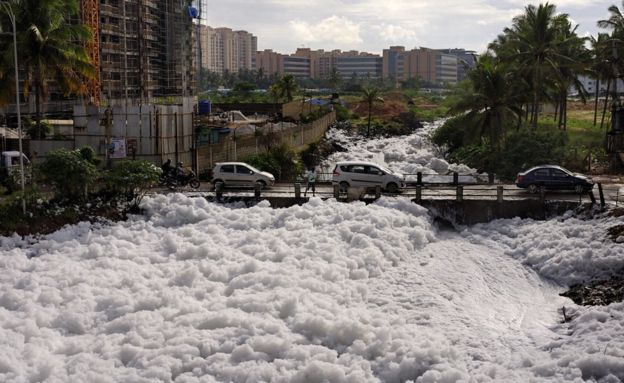Bengaluru Foam : when will the authorities wake up
Bengaluru foam outbreak is in news again. After many reported cases in Bengaluru, yet again two of the major lakes Bellandur and Varthur have started spilling out foam. The lake frothing is the result of the presence of chemicals thus the rains in the city accelerated the action. It is also believed that most of the lakes in the city have turned toxic due to the disposal of toxic debris, industrial and solid wastes. The residents near the lakes have filed a complaint many occasions about the same to the NGT. The NGT has directed to the authorities about the health hazards the pollution is causing in the lakes but to no use. The foam has been hitting the roads and streets and the residents are trapped because of the fear of getting sick.

What is causing this pollution?
- The factories around the lakes pouring chemicals and sewage, including human waste, from residences in the area have caused the lakes to get polluted. A study at the Indian Institute of Science in Bengaluru found that around 90% of the lakes in Bengaluru were affected because of the “sustained inflow of untreated sewage and industrial effluents”.
- The untreated discharge of household waste and industrial effluents into lakes is what causes the toxicity, leading to the water body foaming.
- Another thing to blame is household detergents.
- the growth of population and thus the development needed in the city is another huge cause of this pollution.
What is the danger are the people facing?
- The foam according to studies is carcinogenic in nature which means it can cause cancer.
- It will cause breathing difficulties, irritation on the skin,
- resulting in a pungent stench.
- The residents and livestock are thrown open to water borne diseases, contaminated bore well water, etc.
- Serious water and soil contamination
- Consequent impacts in the food chain.
- Could cause an epidemic in the area.
What has been done to improve the situation?
- The National Green Tribunal has repeatedly criticized Bengaluru’s civic authorities for letting the city’s water bodies become, in effect, toxic waste dumps.
- The Karnataka State Pollution Control Board has taken some steps: such as closing down a number of industries around the lakes and to set up new treatment plants, which are to come up in near future.
What is the legal consequence of the pollution?
- Pollution as under Section 3 of the Water( prevention and control) act, 1974 means any contamination or alteration of the physical, chemical or biological property of water by disposal of any gaseous, liquid or solid substance is Water pollution. Which, in this case, has certainly happened.
- Under the same Act, it is the duty of the State Government to evolve such methods to safely dispose of such industrial and residential wastes, which it has failed at.
- Under the Act, it is prohibited to dump any kind of untreated wastes into any water body
- Any non-compliance to the Act can invite imprisonment or fine on conviction.
- The State Government can also stop the water and electricity supply of the industry which it thinks has contributed to the pollution.
We just finished celebrating the 71st Independence day and it took a matter of 3 days for our country to get hit by its age old problem of pollution. In our opinion, the Civic Bodies should act fast and deal with the problem before it creates an epidemic. The industries causing pollution should be fined and the human waste disposal should be treated before being dumped.
After all how many M.C. Mehta vs. Union of India cases will it take for our country to have a better environment to live in?

